 As a mom you try your best to instill the best habits, behaviors, values, and communication skills with your child, but let’s face it, it’s not easy trying to get a toddler to listen or be attentive for long periods of time especially when it comes to “brushing teeth” and maintaining a good at home preventative care regimen. Working in Pediatrics, I have acquired many tips, tricks, and overall diet “yays” and “nays” that may be beneficial to all parents.
As a mom you try your best to instill the best habits, behaviors, values, and communication skills with your child, but let’s face it, it’s not easy trying to get a toddler to listen or be attentive for long periods of time especially when it comes to “brushing teeth” and maintaining a good at home preventative care regimen. Working in Pediatrics, I have acquired many tips, tricks, and overall diet “yays” and “nays” that may be beneficial to all parents.
Hello all, my name is Sabrina! I am a mother of a three-year-old who is your typical three-year-old (spirited, curious, kind, observant and overwhelming at times). Together we have created a daily schedule/routine that works for us to help maintain a healthy diet, routine, and a good at home preventative care regimen. But let me tell you… it takes patience, time, and a lot of love.
To better understand why at home dental care, routine and diet is so important we must understand what tooth decay is and what causes it. Tooth decay or caries (cavities), are caused by a combination of factors, including bacteria that is present in your mouth, frequent snacking, sipping sugary drinks and not cleaning your teeth well.
DIET
Foods that help keep teeth healthy include:
 Fruits and vegetables: such as apples and carrots, can help remove bacteria that adheres to the surface of the teeth. Melons, celery, pears, and cucumbers that have high water content also help clean teeth and promote overall health.
Fruits and vegetables: such as apples and carrots, can help remove bacteria that adheres to the surface of the teeth. Melons, celery, pears, and cucumbers that have high water content also help clean teeth and promote overall health.
Protein: Lean meats, such as chicken, turkey, and white fish are a good source of protein, which helps strengthen tooth enamel. Nuts and low-sugar peanut butter also provide protein and are a quick energy source for kids.
Calcium-rich products: Low-fat dairy products, such as yogurt and skim milk, are excellent sources of calcium, which is crucial for building strong teeth. Cheese not only delivers calcium, but lingers on teeth and protects them, as well as providing protein and promoting saliva flow.
Contributors to Cavities include:
Sugary drinks: Sweetened juices, sodas, and drinks containing large amounts of sugar should be limited. Even regular milk, especially chocolate milk, contains sugar and should be consumed moderately.
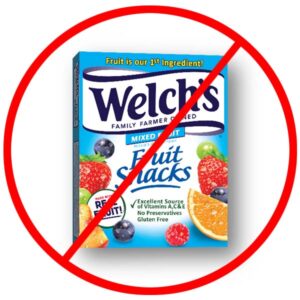 Chewy or sticky foods: Hard or gummy candies, caramel, and chewy granola bars can stick to teeth. THIS INCLUDES “FRUIT” GUMMIES!
Chewy or sticky foods: Hard or gummy candies, caramel, and chewy granola bars can stick to teeth. THIS INCLUDES “FRUIT” GUMMIES!
Desserts: Cookies, cakes, ice cream, and other sweets should be eaten in moderation. If possible, give sweet treats directly after a meal instead of as a snack, since more saliva is present in the mouth after a meal and can help clear away the sugar particles. Like Dr. John Ficarelli says, “I’m never going to tell you to not have a treat It’s OK to have dessert occasionally, but the best time to have a sweet treat is right after your meal!”
Acidic foods and drinks: Citrus fruits and tomatoes contain acid that can wear away tooth enamel if consumed too frequently.
Extra Tips Include:
Limited snacking: Eating frequently without brushing allows food particles to stay on teeth, which fuels the growth of bacteria. Excessive snacking also makes it difficult for the mouth to create enough saliva to adequately keep the teeth clean. My daughter is the snack queen. She is always hungry, but when choosing a snack, we make smarter choices. (Examples: Fresh fruits, cheese, oat bars.)
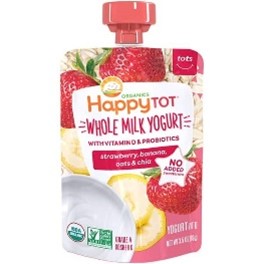
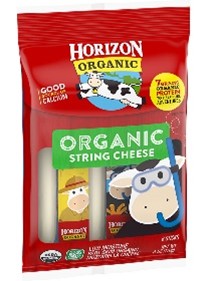
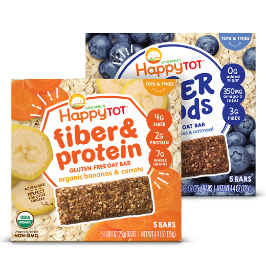
Drink water: Make it a habit to give your child water rather than sweetened beverages. Tap water contains fluoride which strengthens and protects teeth while washing the teeth clean at the same time.
ROUTINE
My husband and I established a daily routine that fits our schedule when we are home with our daughter. We try our best to follow this schedule but sometimes it doesn’t work out… but let me tell you once you establish a routine, your child will know it and sometimes be caught off guard or confused when something is not going as planned.
Routines give infants and toddlers a sense of security and stability. Young children gain an understanding of everyday events and procedures and learn what is expected of them as routines make their environment more predictable.
Our schedule is as follows but (subject to changes daily):
- Wake up
- Help with breakfast / eat breakfast!
- Brush Teeth - Get dressed!
- “Toddler” daily chores
- Play
- Help with lunch / eat lunch!
- Play
- Help with dinner / eat dinner!
- Bath – Pajamas!
- Brush Teeth
- Dance party (very important in our house)
- Read a book
- Bedtime
What works for us may not work for you and that’s OK. Everyone’s lives are busy, different, and unexpected challenges get thrown our way each day. The important thing is to try our best to stick to a schedule but don’t feel like you failed if you had to pick up a pizza on the way home from picking up your little one from daycare, or you’ve been out all-day running errands with your little one in the car!
Just remember although kids do well with routines, kids also love adventure and unexpected surprises!
TIPS AND TRICKS FOR BRUSHING TEETH
For younger children start a daily routine and let them play with the toothbrush
Younger children will chew on the brush, and this will get them used to the look and feel of the toothbrush and the chewing motion can massage the gums and erupting teeth.
Use the “Tell-Show-Do” technique
First, tell your child how to properly brush. Second, show them how it’s done on a doll or stuffed animal. Third, have your child brush their teeth with help from you.
Make it fun!
Let your child pick out their own toothbrush. If they like it, they will use it more. - Blast some tunes! Put on your child’s favorite song and brush the entire length of it. - Sticker charts/rewards/read books about brushing. - Use fluoride toothpaste with a fun flavor!
Best position for the parent and young children for the best control during brushing
Never assume a child brushes well! As kids get older, their oral health habits may get worse. Make sure they are brushing twice a day for at least 2 minutes each time. Never assume any child of any age is doing a thorough job at brushing their teeth. Always be present to teach, observe, time, and follow up with a “check”.
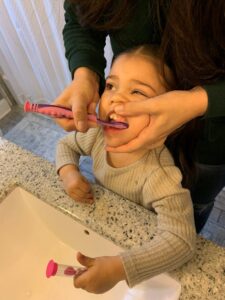
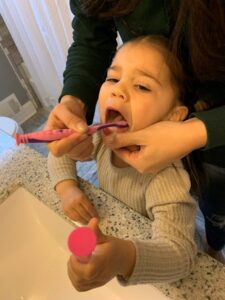
How they should be brushing
Using a pea size amount of fluoride toothpaste, brush teeth and along the gum line. Brush gently in small circles. Clean every tooth thoroughly and brush the inside, outside and chewing surfaces of teeth. After brushing, encourage your child to spit out toothpaste, not to swallow it or rinse with water.
If you use some of these tips and tricks, maintain a heathy diet and establish a daily routine you and your toddler will learn to love at home preventative dental care, and it may turn out to be not so much of a struggle. Remember that patience and a lot of love it key! Happy brushing!
By a loving mom, Sabrina Pereira - Pediatric Clinic Coordinator



